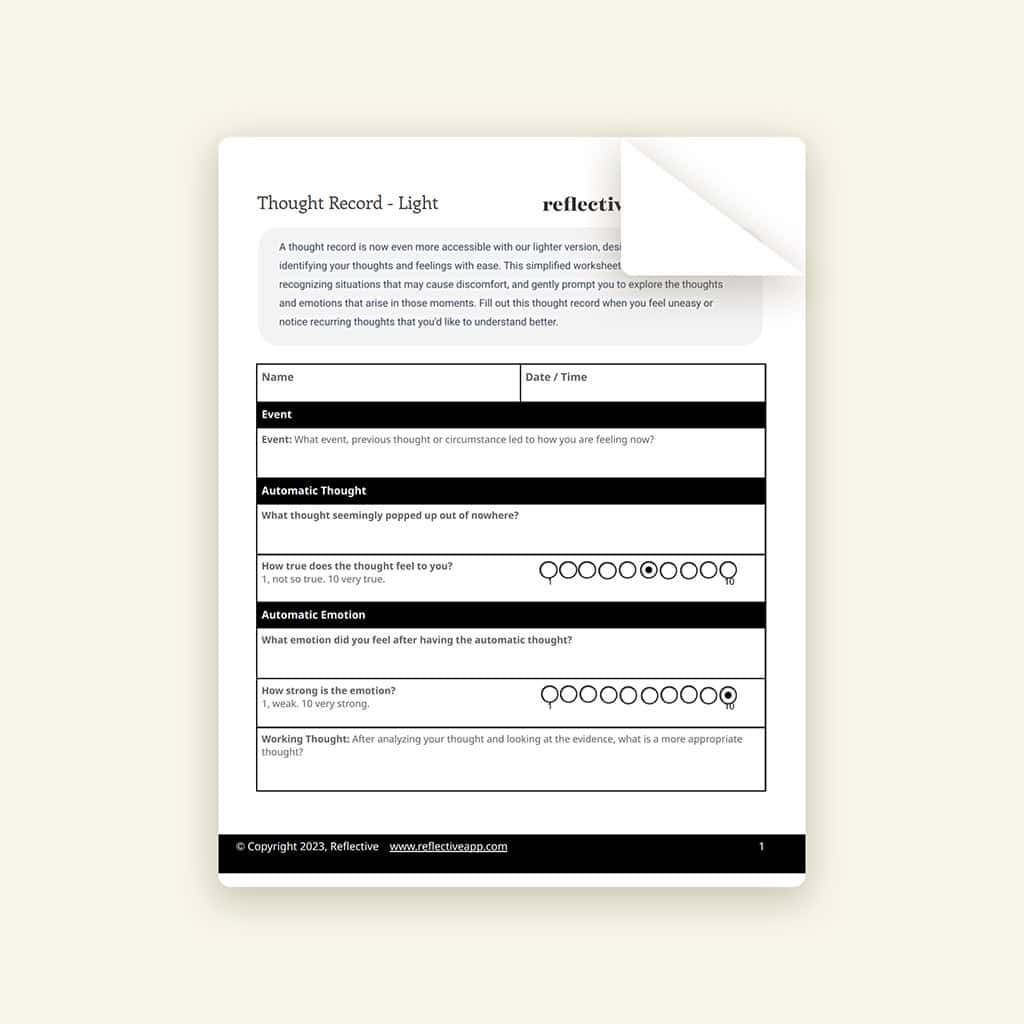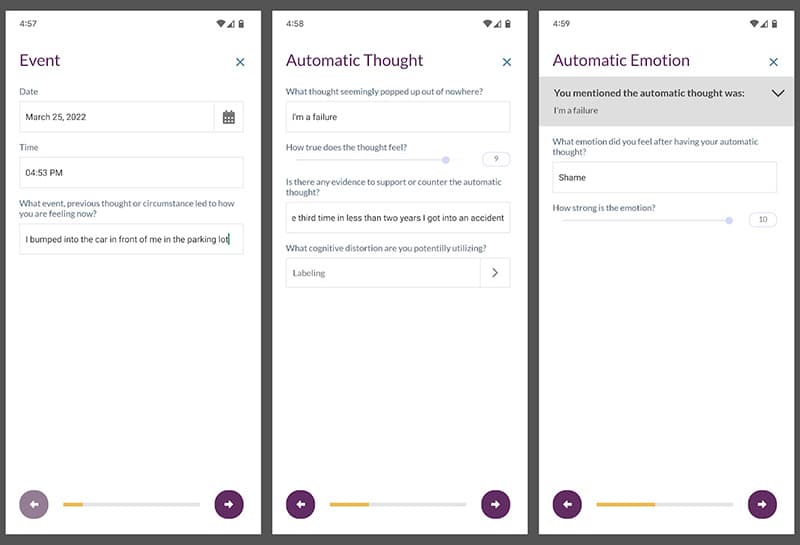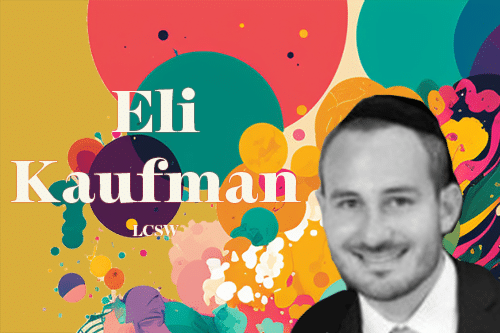Cognitive Diaries, Thought Diaries, and Thought Records
Thought Records, also known as Cognitive Diaries and Thought Diaries, have their roots in Cognitive-Behavioral Therapy (CBT). CBT itself was developed in the 1960s by Dr. Aaron T. Beck, who believed that our thoughts, feelings, and behaviors are interconnected. Dr. Beck proposed that by changing negative thought patterns, we could change our feelings and behaviors. Thought Records became a tool to help individuals identify, challenge, and modify these negative thought patterns.
Table of Contents
- Cognitive Diaries, Thought Diaries, and Thought Records
- Get the Free Download
- The Underlying Principles
- How thought records work
- Applications in Treating Various Conditions
- Two Kinds of Thought Records
- CBT and Brain Processes
- Reflective: The Therapist-Facilitated App
- Get the free Thought Record worksheets
The Underlying Principles

The primary principle behind Thought Records is the cognitive model, which posits that our perceptions influence our reactions. In other words, it’s not the situation itself that determines how we feel, but rather our interpretation of the situation. By describing, examining and challenging these interpretations, we can change our emotional and behavioral responses.
How thought records work
Identification
Begin by pinpointing the problematic or skewed thought. This involves recognizing and labeling the specific cognitive distortion present in one’s thinking. In our example worksheets, cognitive distortions are briefly listed. In the Reflective app, cognitive distortions are listed and defined for patients for them to learn and accurately select the correct distortion.
Evaluation
Evaluation in the context of Thought Records involves a systematic analysis of a specific thought. The individual objectively examines the factual evidence supporting and contradicting the thought. For instance, if someone thinks, “I always fail at everything,” they would list instances where they’ve succeeded and times they’ve faced challenges. This balanced assessment helps in discerning the accuracy and validity of the initial thought, promoting a more realistic perspective
Challenge
Challenging a thought in CBT involves examining its validity and seeking a more balanced perspective. For instance, if a person thinks, “I always fail at everything,” they are encouraged to consider evidence that contradicts this belief, such as past successes or accomplishments. By doing so, they can develop a more nuanced understanding, like “While I’ve faced setbacks, I’ve also had successes.” This process promotes a more objective and less emotionally charged view of situations.
Result
By replacing a negative or distorted thought with a more rational one, individuals often experience a shift in their emotional state. For instance, someone who initially thinks, “I always fail at everything,” might replace this with the more balanced thought, “I’ve had successes and failures; everyone does.” This revised thought can lead to feelings of acceptance and reduced self-criticism, demonstrating the transformative power of cognitive reframing.
Applications in Treating Various Conditions
Anxiety often manifests through catastrophic thinking, where individuals anticipate the worst possible outcomes. Thought Records in CBT guide these individuals to identify such negative anticipations, assess their validity, and reframe them into more balanced perspectives. For example, someone fearing a job interview might think, “I’ll mess up and never get a job.” Through CBT, they can challenge this belief, considering past successes and the improbability of never securing employment, leading to a more constructive thought like, “I’m prepared and have succeeded before; I can do it again.”
Depression often manifests as a series of negative beliefs about oneself, the surrounding world, and future prospects. Thought Records in CBT provide a structured approach to identify these negative beliefs, evaluate their validity, and replace them with more balanced perspectives. For instance, a person might record the thought, “I’ll never succeed in my career.” Through the Thought Record process, they can assess the evidence supporting this belief, challenge its accuracy, and develop a more nuanced view, such as “While I’ve faced career challenges, I’ve also had successes and can learn from my experiences.”
Insomnia can sometimes stem from misconceptions and negative beliefs about sleep. For instance, a person might believe that they absolutely need 8 hours of sleep to function, leading to anxiety when they can’t achieve this. They worry about whether they will get to sleep, stay asleep, and (if they awaken) get back to sleep. Through CBT, individuals can identify and challenge the negative beliefs and thoughts which can lead to behaviors which worsen sleep. Using Thought Records, they can document their thoughts about sleep, evaluate their accuracy, and replace them with more balanced views. For example, recognizing that sleep needs can vary and that quality can be more crucial than quantity can alleviate undue stress, aiding in better sleep patterns.
Thought Records are particularly effective for individuals with Obsessive-Compulsive Disorder (OCD). They provide a structured approach to identify, challenge, and modify obsessive thoughts, thereby diminishing their intensity and influence. For instance, a person with OCD might have a recurring thought that their hands are contaminated. Using a Thought Record, they can document this thought, assess its validity, consider alternative perspectives, and develop a more balanced view, such as recognizing that their hands are clean after washing them adequately. This process helps in reducing the urge to engage in excessive handwashing, a common compulsion in OCD.
PTSD (Post Traumatic Stress Disorder) often results in individuals avoiding situations that remind them of the traumatic event, perpetuating distress. Using a Thought Record Worksheet for CBT help address this by guiding individuals to confront and analyze their traumatic memories. For instance, a veteran experiencing flashbacks from a war event might use a Thought Record to identify the triggering situation, document the distressing thoughts, evaluate their thought distortion, and develop a more balanced perspective. Over time, this practice can reduce avoidance behaviors and promote healing.
For ADHD (Attention Deficit Hyperactivity Disorder), thought records are instrumental in assisting individuals to identify and understand their impulsive thoughts and actions. For instance, a person with ADHD might impulsively blurt out an answer in a meeting without waiting their turn. Through the use of Thought Records, they can pinpoint the triggering thought, such as “I must share this now,” evaluate its accuracy, and develop a more measured response for future situations. This process fosters self-awareness and promotes more deliberate decision-making.
Two Kinds of Thought Records
Light Thought Record: This version is simpler and is designed to train patients or clients in observing their thoughts and feelings without delving too deep. It’s a stepping stone to the more comprehensive version.
Comprehensive Thought Record: This version is more detailed and helps individuals dissect their thoughts, feelings, and behaviors in-depth, examining the triggers, consequences, and alternative responses.
CBT and Brain Processes
Research has shown that CBT can lead to positive outcomes. For instance, a study found that patients with depression who underwent CBT showed changes in the activity of specific regions of the brain associated with mood regulation.
Another study published in Cambridge University Press revealed that activation in neural circuits involved in salience, interoception, and emotional processing predict a positive response to CBT for anxiety disorders.
These studies underscore the idea that our thoughts can indeed influence our brain’s structure and function.

Reflective: The Therapist-Facilitated App
Reflective makes this easier for therapists and their clients. This therapist-facilitated app offers personalized reminders and assignments, ensuring that clients receive what they need. With the therapist’s oversight and the convenience of a digital platform, it strikes the perfect balance.
With Reflective, a therapist can add the precise assignments a patient needs, and it can be customized and set on the schedule that works best for them. Additionally, the build-in accountability and structured connection with their therapist increases treatment compliance and clinical insight. Patients have the convenience and ease of an app in their pocket, with the comforting knowledge their therapist is on the other side of their assignment submissions.


